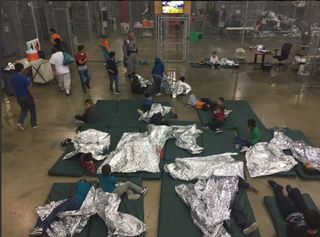Relationships
Migrant Children Shelters: Mats, Meals, but No Human Touch
Separated children are starved of love.
Posted June 23, 2018

Few people who listened to the leaked ProPublica tape of children sobbing for their parents can condone the policy of punishing children as a way of deterring asylum-seeking parents. Those arriving at the United States-Mexican border recently were hit with the “zero-tolerance” policy that has allegedly been suspended for now. But what about the 2,300 children still in shelters? Department of Homeland Security Secretary pointed out that these temporary shelters “provide meals, medical care, and educational services.” Except for the educational services, she might have been describing a veterinary kennel for dogs. However, in kennels dogs often receive a tickle behind the ears; shelters have a “no touch” rule.
July 13th Update -- Deadline to reunite children and parents looming -- but many parents are already lost in the system.
NPR reported on June 15, 2018: Doctors warn about dangers of child separations. Pediatricians concerned about what was happening in the shelters “contacted Colleen Kraft, president of the American Academy of Pediatrics, and she flew to Texas and visited a shelter for migrant children in the Rio Grande Valley. There, she saw a young girl in tears.
"She couldn't have been more than 2 years old," Kraft says. "Just crying and pounding and having a huge, huge temper tantrum. This child was just screaming, and nobody could help her. And we know why she was crying. She didn't have her mother. She didn't have her parent who could soothe her and take care of her."
Further, "Kraft says, the staff told her that federal regulations prevented them from touching or holding the child to soothe her."
Judith L. Herman, MD, psychiatrist, recently wrote “Doctors Concerned About Irreparable Harm to Separated Migrant Children” for Psychology Today, noting that separation from parents is harmful to children.
Herman wrote: “Numerous studies, beginning with Anna Freud’s observations of children separated from their parents during the London Blitz, attest to the long-term harms of separation. Most recently, the well-known ACEs (Adverse Childhood Experiences) survey, conducted jointly by the CDC and Kaiser Permanente, documented the consequences to both physical and mental health . . . adding “Childhood experiences, both positive and negative, have a tremendous impact on future violence victimization and perpetration, and lifelong health and opportunity.”
Children as well as pets are affected by the pain of separation. We often hear of pets that sit at grave sites for their masters. In 2012 a dog named Tommy followed his mistress to daily Mass whenever the church bells rang out. When she died, he followed the coffin into the church. After the funeral whenever he heard the church bells ring, he would head for Santa Maria Assunta in San Donaci and sit at the altar looking at the congregation as if he was expecting his mistress. Bonding is a basic need.
How many children are lost?
There are still 2,300 migrant children without their parents in shelters scattered around the nation. They should be reunited immediately yet the government does not appear to have a database to locate them and match them to a parent. And why are military sites being told to prepare for 20,000 more migrant children. Are we reverting back to our dark history of internment camps that housed the Japanese after World War II?
Perhaps the DHS secretary has never learned of the work of psychologist Harry L. Harlow. In his experiments during the 1950s he constructed a “science of love” model with his controversial monkey experiments. As discussed in the University of Oregon Adoption Studies:
“He separated infant monkeys from their mothers a few hours after birth, then arranged for the young animals to be “raised” by two kinds of surrogate monkey mother machines, both equipped to dispense milk. One mother was made out of bare wire mesh. The other was a wire mother covered with soft terry cloth. Harlow’s first observation was that monkeys who had a choice of mothers spent far more time clinging to the terry cloth surrogates, even when their physical nourishment came from bottles mounted on the bare wire mothers.”
How long can a child be separated before suffering long term trauma? It seems that adverse effects can start almost immediately. Here is what Patricia H. Hawley, Ph.D., says in her recent Psychology Today post: "How long-can a child be safely separated from parents? Shorter than you think."
If this is difficult to imagine, think of yourself. As an adult, if you were ripped away from people you loved, put into a cage with strangers, given a mat to sleep on with a Mylar blanket—or a bed with five others in the room and told you could not touch another human being—including your own siblings—how long before you would be traumatized?
We will probably get an idea of just how upsetting this is to adults when we see the numbers turning up for the march on June 30th: Families Belong Together. And let us keep asking: Where are the girls? Where are they hiding them? Why deny access to those who wish to check on their well being?




